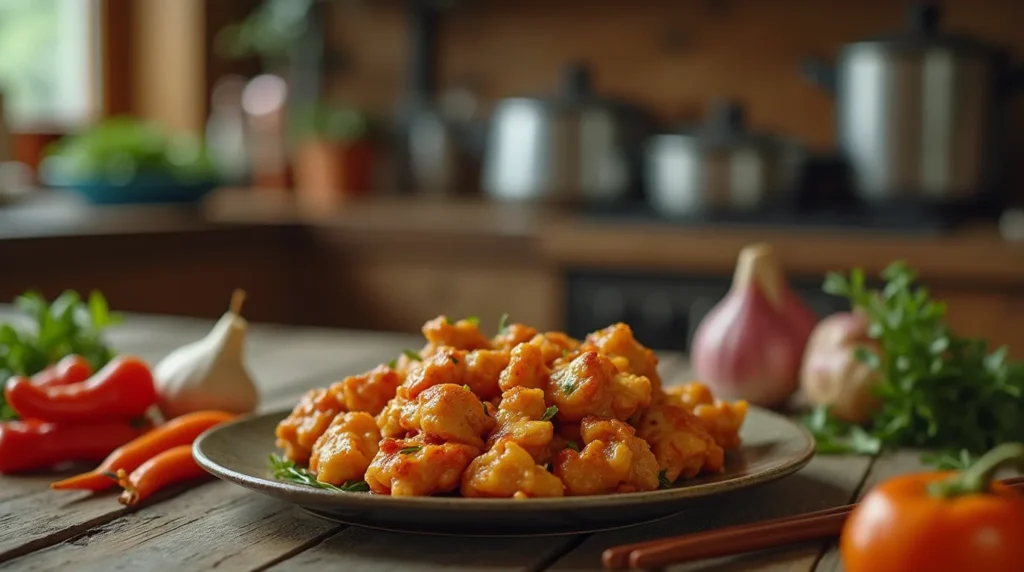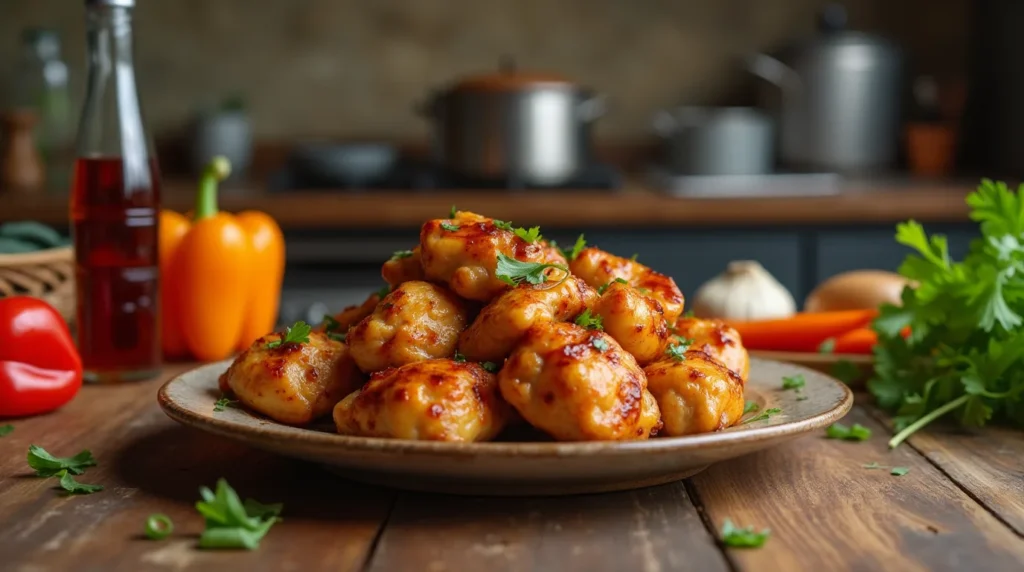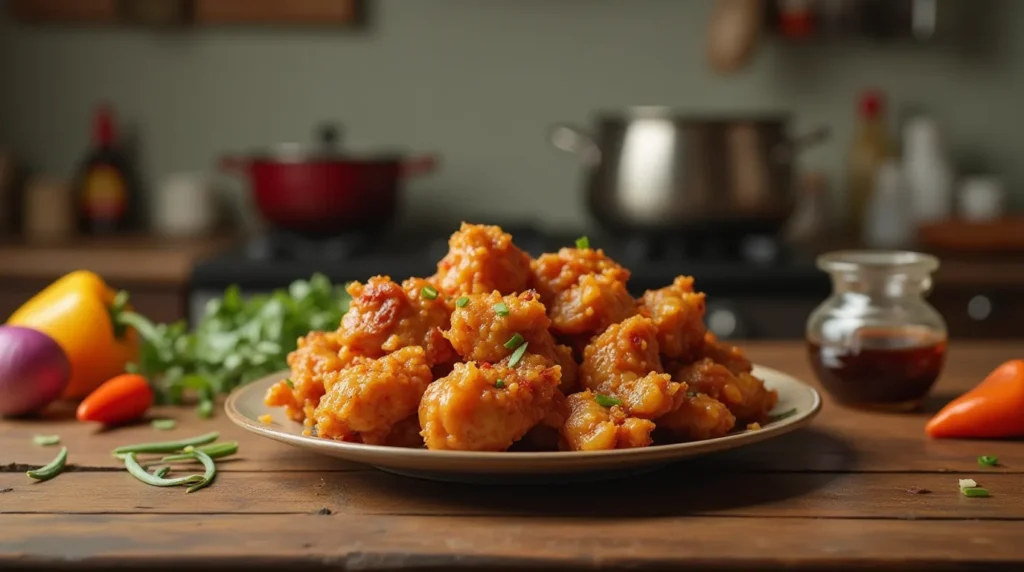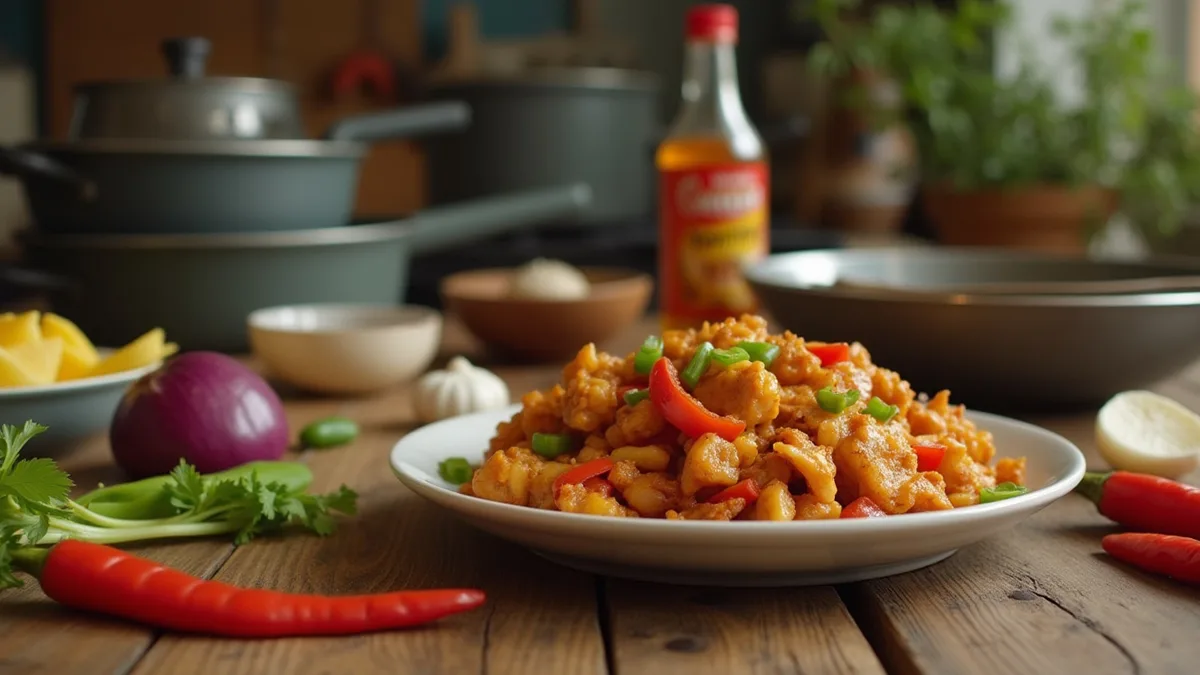Hibachi recipes are not just meals; they are a celebration of cooking that transforms simple ingredients into an unforgettable dining experience. If you’ve ever watched a chef perform impressive tricks at a Japanese steakhouse, you’ve witnessed the magic of hibachi Recipe From the smoky flavors of grilled meats to the perfectly seared vegetables, hibachi recipes have earned their place as some of the most exciting and delicious meals you can prepare.
Whether you’re a seasoned home cook or a beginner looking to try something new, hibachi recipes allow you to infuse your meals with bold flavors and unique techniques. This guide will walk you through everything you need to know about hibachi cooking, including essential tools, ingredients, techniques, and step-by-step recipes. With these tips, you’ll be able to create your very own hibachi experience at home.

What is Hibachi Cooking?
Hibachi cooking refers to the method of preparing food on a traditional Japanese grill, often called a hibachi. The grill itself is small and portable, usually with an open flame. While many people associate hibachi cooking with the theatrical performances of chefs at Japanese steakhouses, the term hibachi in Japan is actually more related to the type of grill used than the cooking technique.
In Japan, hibachi traditionally refers to a small, portable grill, typically used for grilling skewers of meat or vegetables. It is different from teppanyaki, another form of Japanese grilling where food is cooked on a flat, iron grill. While both methods involve high heat and fresh ingredients, hibachi cooking is unique in its ability to create a smokier flavor due to the open flames.
Hibachi cooking, particularly at Japanese steakhouses, involves more than just grilling food – it’s an interactive culinary performance. Hibachi chefs typically prepare meals in front of customers, showcasing their knife skills and precision in cutting and cooking. For a more thorough explanation of Japanese cooking methods, check out this guide to teppanyaki recipes.
The Essential Hibachi Tools
To replicate the hibachi experience at home, you’ll need some key equipment and tools. While many people think you need a specialized hibachi grill, you can use a regular grill or even a stovetop griddle to get similar results. Here’s what you’ll need:
Hibachi Grill
If you want the authentic hibachi experience, investing in a hibachi grill can be a game changer. These small, compact grills are designed to hold charcoal or wood, giving you the ability to achieve that signature smoky flavor. They are perfect for cooking meats, vegetables, and seafood, especially when you want to infuse them with a natural, grilled taste.
- Charcoal Hibachi Grills: These are traditional grills that use charcoal for fuel. They offer a high level of control over heat, which is essential for hibachi cooking.
- Gas Hibachi Grills: If you prefer convenience, a gas-powered hibachi grill might be the way to go. They provide consistent heat and are easy to use.
For those without access to a hibachi grill, a cast iron griddle can serve as an excellent alternative. A heavy-duty skillet, when preheated, mimics the direct, high heat used in hibachi cooking. If you are looking to improve your skills in grilling, try the best tips for grilling with cast iron to get a professional touch on your hibachi recipes.
Hibachi Grilling Tools
To make the process smoother, certain grilling tools are helpful:
- Tongs and spatulas: A long pair of tongs and a spatula will give you the control you need to flip and move food on the grill.
- Grill Brush: A grill brush will help keep your grill clean and free of excess grease or burnt food.
- Basting Brushes: Use these to apply sauces or marinades to meats while they cook, keeping them moist and flavorful.
These tools ensure you can handle the food safely and with precision, especially when working with delicate ingredients like shrimp or thinly sliced steak.

Hibachi Cooking Techniques
The Importance of High Heat
The key to successful hibachi cooking is the use of high heat. This high temperature allows for quick searing of meats, locking in juices, and giving the food that crispy, caramelized exterior. It also helps vegetables cook faster while retaining their natural sweetness and crunch.
- Preheat Your Grill: Before you start cooking, make sure your hibachi grill is properly preheated. Whether you’re using charcoal or gas, it’s essential that the grill is hot enough for searing. Allow the grill to reach a high temperature, ideally around 450°F to 500°F (232°C to 260°C).
- Direct vs. Indirect Heat: Hibachi cooking often uses direct heat, meaning the food is placed directly over the flames or heat source. This method is ideal for quick-cooking proteins like shrimp and thin cuts of meat. However, you can also use indirect heat for longer cooking items like larger pieces of chicken or vegetables.
If you want to dive deeper into temperature control in grilling, be sure to read grill temperature tips for perfect meats.
Ingredients for Hibachi Recipes
While the hibachi grill itself plays a central role, the ingredients you choose can make or break your dish. Here are the most popular ingredients used in hibachi cooking:
Meats
Hibachi recipes typically feature tender cuts of meat, including chicken, beef, and pork. Seafood is also a popular choice. The most common meats for hibachi dishes are:
- Chicken: Boneless, skinless chicken breasts or thighs are perfect for hibachi cooking. They cook quickly and remain juicy.
- Beef: Ribeye steaks or tenderloin are great choices for hibachi beef. These cuts offer great flavor and tenderness when cooked over high heat.
- Shrimp: Shrimp is a staple in hibachi cooking. It cooks quickly and absorbs flavors well.
Vegetables
Hibachi is a great way to enjoy vegetables that are full of flavor and have a delightful crunch. Here are some of the most common vegetables used in hibachi dishes:
- Zucchini: Sliced thin, zucchini grills well and adds a nice balance to your hibachi meal.
- Onions: Sliced onions caramelize beautifully on the grill, providing natural sweetness.
- Mushrooms: Mushrooms absorb the smoky flavors of the grill, becoming tender and savory.
- Bell Peppers: Colorful bell peppers add a fresh crunch and sweet flavor to your dish.
For a quick vegetable side dish, check out this guide to grilling vegetables.
Sauces and Seasonings
The sauces and seasonings you use in hibachi cooking are what truly make the dish stand out. Here’s a list of essential hibachi seasonings:
- Soy Sauce: This is the base of many hibachi sauces. It adds umami and a salty depth of flavor.
- Garlic Butter: A key element of hibachi cooking, garlic butter brings richness and flavor to the grill.
- Sesame Oil: This oil imparts a nutty flavor that complements grilled meats and vegetables.
- Ginger: Fresh ginger adds a refreshing zing to sauces and marinades.
Popular Hibachi Recipes to Try
Now that you know the essential ingredients, let’s explore some hibachi recipes that are sure to impress. Each recipe below features ingredients commonly found in hibachi dishes, from meats and seafood to rice and vegetables.
Hibachi Chicken Recipe
Hibachi chicken is one of the most popular options. It’s quick, easy, and packed with flavor.
Ingredients
- 2 chicken breasts, cut into cubes
- 2 tablespoons soy sauce
- 1 tablespoon sesame oil
- 1 teaspoon garlic powder
- 1 teaspoon ground ginger
Instructions
- Marinate the chicken in soy sauce, sesame oil, garlic powder, and ginger for 30 minutes.
- Preheat your grill to high heat.
- Grill the chicken for 5-7 minutes, turning occasionally until the chicken is cooked through and browned on all sides.
- Serve the chicken with grilled vegetables and steamed rice for a complete meal.
If you’re looking for a chicken recipe with a twist, check out how to make the best chicken fajitas recipe.
Hibachi Shrimp Recipe
Shrimp hibachi is a delightful combination of sweet and savory flavors. The key to this recipe is to cook the shrimp quickly over high heat to preserve its tender texture.
Ingredients
- 1 pound shrimp, peeled and deveined
- 1 tablespoon butter
- 1 tablespoon soy sauce
- 1 teaspoon garlic powder
- 1 tablespoon sesame oil
- Lemon wedges for serving
Instructions
- Toss the shrimp in melted butter, soy sauce, sesame oil, and garlic powder.
- Grill the shrimp for 2-3 minutes per side until they are pink and opaque.
- Serve the shrimp with lemon wedges and a side of hibachi rice.
For more seafood recipes, try the perfect salmon grilling recipe.
Tips for the Perfect Hibachi Meal
Creating the perfect hibachi meal is all about technique. Here are some tips to help you improve your hibachi skills:
- Don’t overcrowd the grill: Make sure you leave enough space between the ingredients to allow for even cooking.
- Cook in batches: If you have a lot of food, cook in smaller batches to ensure each piece gets that perfect sear.
- Use fresh ingredients: Fresh, high-quality ingredients will make a big difference in the flavor of your hibachi dishes.

Frequently Asked Questions (FAQs)
1. What is the difference between hibachi and teppanyaki?
While both hibachi and teppanyaki involve grilling, hibachi uses a traditional Japanese grill with an open flame, while teppanyaki is typically done on a flat, iron griddle. Teppanyaki cooking is more common in Japanese steakhouses, where chefs perform intricate cooking techniques in front of guests.
2. Can I make hibachi without a grill?
Yes, you can make hibachi without a traditional hibachi grill. You can use a cast iron griddle, stovetop, or even a regular outdoor grill to get similar results. Just be sure to preheat your surface properly and use high heat for searing.
Conclusion
Hibachi cooking is an exciting and rewarding experience that brings bold, smoky flavors to the table. Whether you’re grilling up shrimp, chicken, or vegetables, hibachi recipes are versatile and easy to adapt. By following the right techniques and using fresh ingredients, you can bring the hibachi restaurant experience right into your home.
Ready to cook? Fire up your grill and start experimenting with these delicious hibachi recipes today!
Print
The Ultimate Guide to Hibachi Recipe
- Total Time: 1 hour
- Yield: 4 servings 1x
- Diet: Low Calorie
Description
Discover the art of making delicious hibachi recipes at home with this easy-to-follow guide. Learn how to prepare hibachi chicken, shrimp, vegetables, and more using essential cooking techniques. From choosing the right ingredients to mastering the grilling process, this post provides expert tips and step-by-step instructions for creating mouthwatering hibachi meals right in your own kitchen. Whether you’re a beginner or an experienced cook, these simple and flavorful hibachi recipes will bring the restaurant experience to your home.
Ingredients
- 2 boneless, skinless chicken breasts (cut into bite-sized pieces)
- 2 tablespoons vegetable oil (or sesame oil)
- 2 tablespoons soy sauce
- 1 tablespoon teriyaki sauce (optional)
- 1 teaspoon garlic powder
- 1 teaspoon onion powder
- 1 tablespoon fresh lemon juice (optional for extra zest)
- 1/2 teaspoon ground black pepper
- 1/2 teaspoon salt (or to taste)
- 1 teaspoon ginger (freshly grated or powdered)
- 1 tablespoon butter (for finishing)
- 1 tablespoon sesame seeds (optional for garnish)
- Chopped green onions (for garnish)
- 1 cup rice (cooked, for serving)
- 1 cup mixed vegetables (like carrots, zucchini, and onions)
- Lemon wedges (for garnish, optional)
Instructions
-
Prepare the Ingredients:
- Start by cutting the boneless, skinless chicken breasts into bite-sized pieces.
- Chop the vegetables (such as carrots, zucchini, and onions) into thin strips or small pieces, ready for grilling.
- Cook your rice according to package instructions and set aside.
-
Marinate the Chicken:
- In a medium bowl, mix together the soy sauce, teriyaki sauce (if using), garlic powder, onion powder, ginger, lemon juice, black pepper, and salt.
- Add the chicken pieces to the marinade and stir well to coat. Let the chicken marinate for at least 15-30 minutes to absorb the flavors.
-
Heat the Grill or Griddle:
- Preheat a hibachi grill, cast-iron griddle, or a large skillet over medium-high heat. Add 1 tablespoon of vegetable oil (or sesame oil) and allow it to heat until shimmering.
-
Cook the Chicken:
- Once the grill or pan is hot, add the marinated chicken pieces in a single layer. Sear the chicken on one side for about 3-4 minutes without moving it, allowing it to develop a nice crust.
- Flip the chicken pieces and cook for another 3-4 minutes, until fully cooked through and golden brown on all sides.
- Remove the chicken from the grill or pan and set it aside.
-
Grill the Vegetables:
- Add a bit more oil to the grill or pan if needed, and toss in your prepared vegetables. Stir-fry them for about 4-5 minutes, until they’re tender but still crisp and slightly charred. You can add a pinch of salt and pepper for seasoning.
-
Finish the Dish:
- Once the vegetables are cooked, add the cooked chicken back into the pan with the veggies. Add a tablespoon of butter and allow it to melt over the chicken and vegetables, tossing everything together to coat with the butter.
- Optionally, sprinkle some sesame seeds over the top and garnish with chopped green onions for a fresh, flavorful touch.
-
Serve:
- Serve the hibachi chicken and vegetables with a side of rice. You can also garnish with lemon wedges for an added burst of freshness.
-
Enjoy:
- Your delicious hibachi chicken is ready to be enjoyed! Serve it with a cold drink and enjoy the smoky, savory flavors of this homemade hibachi meal.
Notes
-
Ingredient Substitutions:
- If you don’t have teriyaki sauce, you can skip it or substitute with extra soy sauce or a splash of honey for sweetness.
- If you prefer a different protein, steak, shrimp, or tofu are excellent alternatives for this recipe.
-
Marinating Time:
- The longer the chicken marinates, the more flavorful it will be. Ideally, marinate the chicken for 30 minutes to an hour. However, even 15 minutes will give a decent flavor boost.
-
Oil Choices:
- Using sesame oil will impart a more authentic hibachi flavor, but vegetable oil works just as well if you prefer a milder taste.
-
Rice:
- For an extra twist, try using fried rice instead of plain rice. You can even cook the rice on the hibachi grill with soy sauce and vegetables for a complete hibachi meal.
-
Vegetable Variations:
- Feel free to use any vegetables you like. Mushrooms, broccoli, and bell peppers are all great options for hibachi-style grilling.
-
Serving Suggestions:
- Serve the hibachi chicken with traditional yum yum sauce, soy sauce, or ginger dressing on the side for extra flavor.
- For a more authentic hibachi experience, you can also prepare some hibachi-style shrimp or steak on the side.
-
Grilling Tips:
- Don’t overcrowd the grill or pan. This will ensure that the food sears properly and doesn’t steam.
- If you’re using a griddle or grill, cook the chicken and vegetables in batches for the best results.
-
Leftovers:
- Hibachi chicken leftovers can be stored in an airtight container in the refrigerator for up to 3-4 days. Reheat gently on the stovetop to avoid overcooking.
-
Garnishing:
- Garnish the dish with chopped cilantro or green onions for a fresh, flavorful finish.
- Prep Time: 45 minutes
- Cook Time: 16 minutes
- Category: Main Course
- Cuisine: Japanese
Nutrition
- Serving Size: Per Serving
- Calories: 400 kcal
- Sugar: 6g
- Sodium: 600mg
- Fat: 15g
- Saturated Fat: 2g
- Carbohydrates: 25g
- Fiber: 5g
- Protein: 40g
- Cholesterol: 75mg
Keywords: diet-friendly hibachi recipe, healthy hibachi meal, low-calorie hibachi, hibachi recipe for weight loss, healthy hibachi ingredients, lean protein hibachi, hibachi with tofu, hibachi chicken recipe, hibachi shrimp recipe, low-carb hibachi, hibachi vegetables, hibachi cauliflower rice, hibachi with brown rice, low-sodium hibachi sauce, grilled vegetables hibachi, hibachi cooking tips, high-protein hibachi, healthy Japanese recipes, teppanyaki-style meal, light hibachi dinner, hibachi stir-fry, hibachi vegetable stir-fry

